

Ancient_greece. Ancient Times. Vikings. Facilitated by advanced seafaring skills, and characterised by the longship, Viking activities at times also extended into the Mediterranean littoral, North Africa, the Middle East and Central Asia.
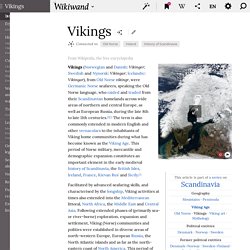
Following extended phases of (primarily sea- or river-borne) exploration, expansion and settlement, Viking (Norse) communities and polities were established in diverse areas of north-western Europe, European Russia, the North Atlantic islands and as far as the north-eastern coast of North America. This period of expansion witnessed the wider dissemination of Norse culture, while simultaneously introducing strong foreign cultural influences into Scandinavia itself, with profound developmental implications in both directions. Norse art. Timeline for the Norse animal styles.
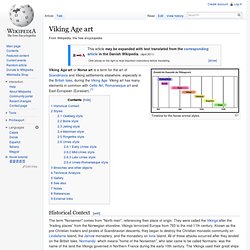
Viking Age art or Norse art is a term for the art of Scandinavia and Viking settlements elsewhere, especially in the British Isles, during the Viking Age. Viking art has many elements in common with Celtic Art, Romanesque art and East-European (Eurasian).[1] Historical Context[edit] Styles[edit] Mead hall. A reconstructed Viking Age longhouse (28.5 metres long). In ancient Scandinavia and Germanic Europe a mead hall or feasting hall was initially simply a large building with a single room. From the fifth century to early medieval times such a building was the residence of a lord and his retainers. Longhouse. A longhouse or long house is a type of long, proportionately narrow, single-room building built by peoples in various parts of the world including Asia, Europe and North America.
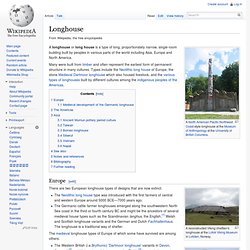
Many were built from timber and often represent the earliest form of permanent structure in many cultures. Types include the Neolithic long house of Europe, the stone Medieval Dartmoor longhouse which also housed livestock, and the various types of longhouses built by different cultures among the indigenous peoples of the Americas. Europe[edit] There are two European longhouse types of designs that are now extinct. Mead. Mead (/ˈmiːd/; archaic and dialectal "medd"; from Old English "meodu"[1]), is an alcoholic beverage created by fermenting honey with water, and frequently fruits, spices, grains or hops.[2][3][4] (Hops act as a preservative and produce a bitter, beer-like flavor.)
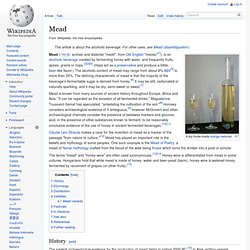
The alcoholic content of mead may range from about 8% ABV[5] to more than 20%. History of the Ancient World: Rosetta stone. Ever since its rediscovery, the stone has been the focus of nationalist rivalries, including its transfer from French to British possession during the Napoleonic Wars, a long-running dispute over the relative value of Young and Champollion's contributions to the decipherment, and since 2003, demands for the stone's return to Egypt.
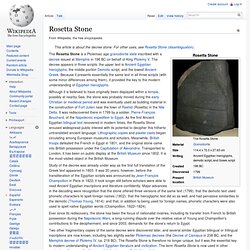
Description[edit] Original stele[edit] Japan. Coordinates: 35°N 136°E / 35°N 136°E / 35; 136 You may need rendering support to display the Japanese text in this article correctly.

Japan ( i/dʒəˈpæn/; Japanese: 日本 Nippon [nip̚põ̞ɴ] or Nihon [nihõ̞ɴ]; formally 日本国 Nippon-koku or Nihon-koku, "State of Japan") is an island country in East Asia. China. China, officially the People's Republic of China (PRC), is a sovereign state in East Asia.

It is the world's most populous country, with a population of over 1.38[14] billion. The PRC is a one-party state governed by the Communist Party, with its seat of government in the capital city of Beijing. It exercises jurisdiction over 22 provinces; five autonomous regions; four direct-controlled municipalities (Beijing, Tianjin, Shanghai and Chongqing); two mostly self-governing special administrative regions (Hong Kong and Macau); and claims sovereignty over Taiwan. Covering approximately 9.6 million square kilometers, China is the world's second-largest country by land area,[16] and either the third or fourth-largest by total area, depending on the method of measurement. History of Chinese art. Chinese art is visual art that, whether ancient or modern, originated in or is practiced in China or by Chinese artists.
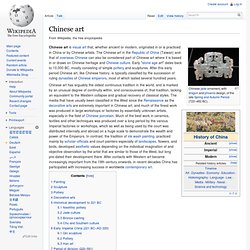
The Chinese art in the Republic of China (Taiwan) and that of overseas Chinese can also be considered part of Chinese art where it is based in or draws on Chinese heritage and Chinese culture. Early "stone age art" dates back to 10,000 BC, mostly consisting of simple pottery and sculptures. Egypt. Egypt ( i/ˈiːdʒɪpt/; Arabic: مِصر Miṣr, Egyptian Arabic: مَصر Maṣr, Coptic: Ⲭⲏⲙⲓ Khemi), officially the Arab Republic of Egypt, is a transcontinental country spanning the northeast corner of Africa and southwest corner of Asia, via a land bridge formed by the Sinai Peninsula.

It is the world's only contiguous Eurafrasian nation. Most of Egypt's territory of 1,010,408 square kilometres (390,000 sq mi) lies within the Nile Valley. Egypt is a Mediterranean country. Egyptian language. History_of_Egypt. This article or section might be slanted towards recent events.

Please try to keep recent events in historical perspective. (April 2014) The history of Egypt has been long and rich, due to the flow of the Nile river, with its fertile banks and delta. Its rich history also comes from its native inhabitants and outside influence. The Egyptian Book of the Dead Index. Sacred Texts Egypt The Papyrus of Ani by Introduction Translation. Ephesus. Ephesus (/ˈɛfəsəs/;[1] Greek: Ἔφεσος Ephesos; Turkish: Efes) was an ancient Greek city[2][3] on the coast of Ionia, three kilometers southwest of present-day Selçuk in İzmir Province, Turkey.
AncientWeb.org: The Ancient Worlds Great Civilizations. Cartouche. Of the five royal titularies it was the prenomen, the throne name, also referred to as the, and the "Son of Ra" titulary,[3] the so-called nomen, the name given at birth, which were enclosed by a cartouche.[4] At times amulets were given the form of a cartouche displaying the name of a king and placed in tombs. Such items are often important to archaeologists for dating the tomb and its contents.[5] Cartouches were formerly only worn by Pharaohs. The oval surrounding their name was meant to protect them from evil spirits in life and after death. The cartouche has become a symbol representing good luck and protection from evil .[6] Egyptians believed that one who had their name recorded somewhere would not disappear after death. A cartouche attached to a coffin satisfied this requirement.[7] There were periods in Egyptian history when people refrained from inscribing these amulets with a name, for fear they might fall into somebody's hands conferring power over the bearer of the name.[8]
Egyptian hieroglyphs. Etymology History and evolution Hieroglyphs emerged from the preliterate artistic traditions of Egypt. For example, symbols on Gerzean pottery from ca. 4000 BCE resemble hieroglyphic writing.